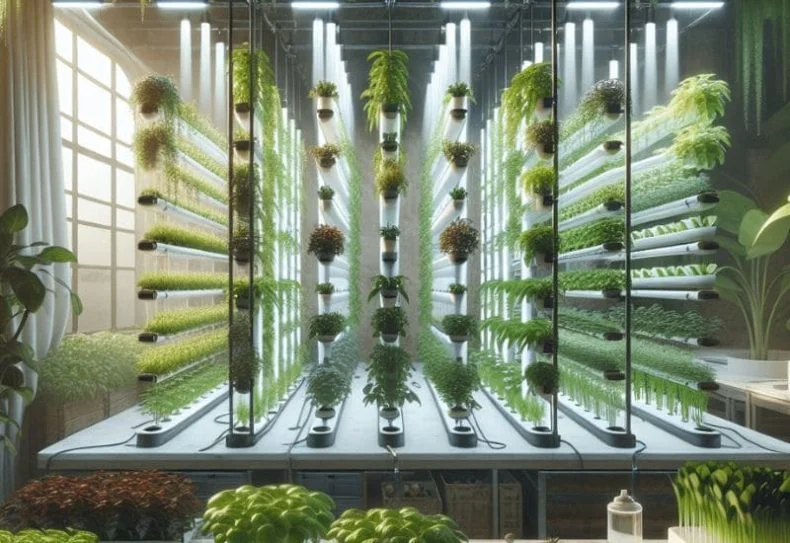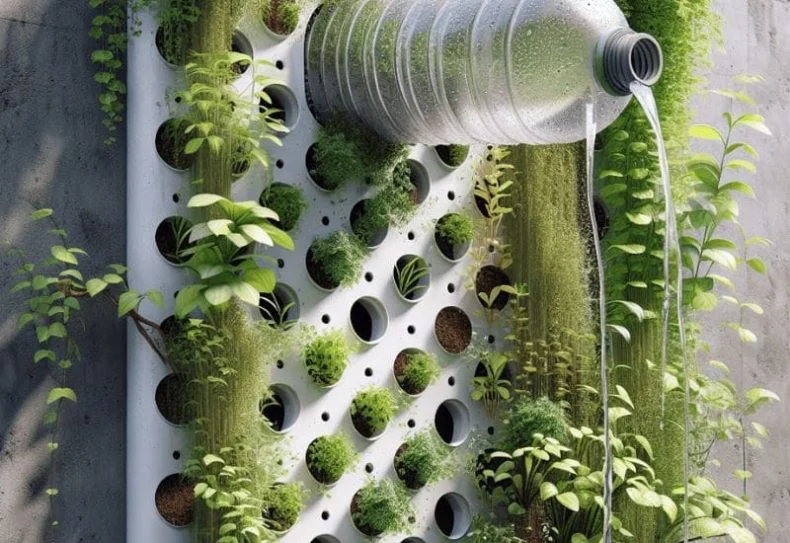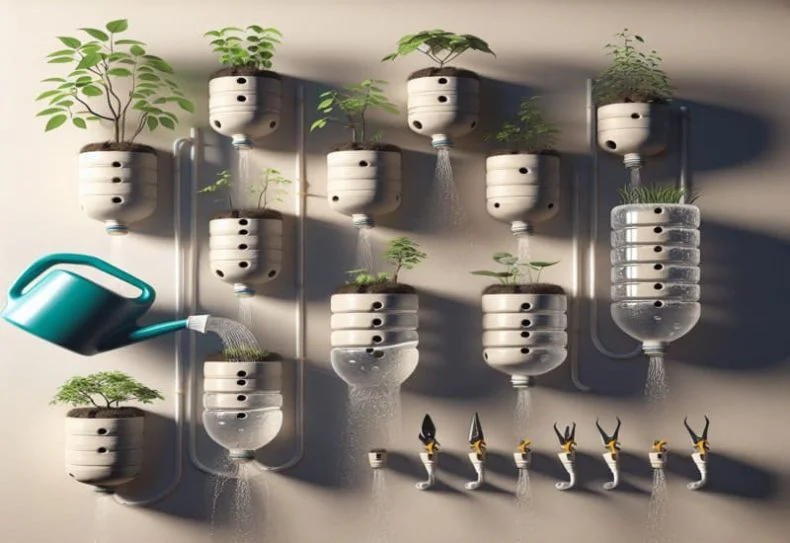Vertical Garden Watering Systems: Indoors and Outside

Introduction
Vertical gardens bring a touch of nature closer to home and offer endless possibilities for creating stunning living artworks.
In this article, we explore the art and science of vertical garden watering systems, uncovering the essential techniques, tips, and best practices to help you cultivate flourishing greenery in your vertical garden oasis.
Understanding Vertical Garden Watering Systems
What are Vertical Garden Watering Systems?
Vertical garden watering systems are specially designed irrigation setups that deliver water to plants in a vertical garden environment.
These systems are engineered to efficiently hydrate plants while optimizing water usage and minimizing runoff.
By utilizing smart technology and sustainable practices, vertical garden watering systems provide an eco-friendly and effective way to nourish your plants.
Vertical garden watering systems consist of several key components that work together to ensure proper hydration and nourishment for the plants. Some of the essential components include:
- Irrigation Pipes: These pipes carry water from the source to the plants, ensuring even distribution and efficient usage.
- Drip Emitters: These small devices are attached to the irrigation pipes and deliver controlled amounts of water directly to the plant roots.
- Timer Systems: Automated timers regulate the watering schedule, ensuring consistency and reliability.
- Smart Sensors: These sensors monitor soil moisture levels, humidity, and other environmental factors to optimize watering frequency and duration.
- Filtration Systems: Filters remove impurities from the water, maintaining the health of the plants and the integrity of the system.
In addition to efficient hydration and water conservation, vertical garden watering systems offer several other benefits:
- Space Optimization: These systems allow for vertical plant growth, making the most of limited space in urban environments or small gardens.
- Enhanced Aesthetics: The use of intricate irrigation setups can add a visually appealing and artistic element to the garden.
- Environmental Sustainability: By minimizing water waste and promoting plant health, these systems contribute to sustainable gardening practices.
- Customization and Control: Gardeners can tailor the watering settings to suit the specific needs of different plant species and environmental conditions.
Importance of Proper Watering
Proper watering is vital to the health and vitality of plants in a vertical garden.
The unique growing conditions in vertical gardens require careful attention to watering techniques in order to maintain plant health and promote optimal growth.
By understanding the importance of proper watering, gardeners can create thriving vertical gardens that brim with life and beauty.
Types of Vertical Garden Watering Systems
Drip Irrigation Systems
Drip irrigation systems work by using plastic bottles with recirculation pipes that have holes in them. An automatic system delivers water directly to the base of plants in controlled amounts. This targeted approach minimizes water waste and ensures that plants receive the precise amount of hydration they need for healthy growth. The recirculation pipes with holes ensure efficient water distribution and are well-suited for a variety of plant types.
Hydroponic Systems

- Improved plant growth through direct delivery of essential nutrients
- Optimized water usage and conservation
- Space-efficient and sustainable solution for vertical gardens
Hydroponic systems are versatile and can be adapted to various plant types, making them suitable for a wide range of crops. By eliminating the need for soil, these systems reduce the risk of soil-borne diseases and pests, providing a cleaner and healthier environment for plant cultivation. Additionally, the controlled environment of hydroponic systems ensures consistent and efficient nutrient absorption by the plants, resulting in higher yields and faster growth rates.
Types of hydroponic systems include:
System TypeDescriptionNutrient Film Technique (NFT)Plants grow in a shallow stream of nutrient-rich waterDeep Water Culture (DWC)Plants suspended in oxygenated nutrient solutionVertical Hydroponic SystemsPlants are stacked vertically, maximizing space efficiency
Wicking Systems
- Wicking systems utilize passive hydroponic principles to draw water from a reservoir to the plant roots through capillary action.
- This self-watering approach eliminates the need for complex irrigation setups and provides a low-maintenance solution for watering plants in a vertical garden.
- Wicking systems are ideal for small-scale vertical gardens and are an excellent choice for novice gardeners.
- They can be made from readily available materials, making them cost-effective and accessible for DIY projects.
- Plants grown in wicking systems exhibit stronger root systems due to consistent moisture levels, leading to healthier growth and higher yields.
- These systems can be easily customized to accommodate various plant types and sizes, offering versatility in vertical garden designs.
Choosing the Right Watering System for Your Vertical Garden
Factors to Consider
- Plant Species: Different plant species have varying water requirements, so it’s important to consider the specific needs of the plants in your vertical garden.
- Garden Size: The size of your garden will determine the scale of the watering system required. Larger gardens may need a more complex irrigation setup.
- Climate: Consider the climate of your location, including temperature, humidity, and rainfall patterns, as these factors influence the watering needs of your vertical garden.
- Available Resources: Evaluate the availability of resources such as water supply, electricity, and maintenance support. This will help determine the most practical watering system for your garden.
Best Watering System for Different Plant Types
- Drip Irrigation: This system works well for plants that require consistent moisture, such as vegetables and flowers. The slow, steady application of water directly to the roots minimizes water loss and reduces the risk of fungal diseases.
- Soaker Hoses: Ideal for plants with shallow root systems, soaker hoses provide gentle, consistent watering. They are especially beneficial for ground cover, shrubs, and young trees.
- Hydroponic Systems: These systems are suitable for moisture-loving plants, such as lettuce, herbs, and certain flowering species. They deliver a nutrient-rich, water-based solution directly to the plant roots, promoting rapid growth and high yields.
- Wicking Systems: Drought-tolerant plants, like succulents and cacti, thrive in wicking systems. These systems provide consistent moisture to the plants while preventing water waste.
- Self-Watering Planters: These are great for busy gardeners. They use a water reservoir to supply moisture to the plants as needed, reducing the frequency of manual watering and maintaining consistent moisture levels.
When deciding on the best watering system for your vertical garden, consider the water needs of your specific plant varieties. By understanding the different watering systems available and the requirements of your plants, you can effectively select the most suitable option for your garden’s success.
Installation and Maintenance of Vertical Garden Watering Systems
Installation Guide
Installing a vertical garden watering system involves careful planning, placement, and setup to ensure optimal coverage and efficiency. Whether you choose a drip irrigation, hydroponic, or wicking system, following the installation guidelines is key to establishing a reliable and effective watering infrastructure for your vertical garden.
Maintenance Tips
Regular maintenance is crucial for keeping vertical garden watering systems in optimal working condition. This entails monitoring water levels, inspecting for clogs or malfunctions, and adjusting watering schedules as needed. By implementing routine maintenance practices, you can ensure that your vertical garden watering system continues to support healthy plant growth and flourishing greenery.
Optimizing Watering Schedules for Vertical Gardens
Seasonal Adjustments
Adapting watering schedules to seasonal changes is essential for accommodating varying environmental conditions and plant requirements, especially in indoor vertical gardens. As climate and weather patterns fluctuate, it’s important to adjust watering frequencies and durations to align with the needs of your indoor vertical garden throughout different seasons. This proactive approach helps sustain healthy and resilient plant growth year-round.
- Temperature: In warmer seasons, plants may require more frequent watering due to increased evaporation, which is particularly important in indoor environments where temperature regulation may vary.
- Rainfall Patterns: Consider the natural precipitation levels in your geographic region and adjust watering accordingly, taking into account the unique conditions of indoor settings.
- Humidity Levels: High humidity can affect soil moisture, requiring adjustments in watering schedules, especially in enclosed indoor spaces.
- Plant Growth Phases: Different stages of plant growth may necessitate varying watering needs, an important consideration for indoor vertical gardens.
Below are general recommendations for adjusting watering schedules based on seasonal changes for indoor vertical gardens:
SeasonWatering FrequencySpring2-3 times per weekSummer3-4 times per weekFall2-3 times per weekWinter1-2 times per week
Recommended Watering Frequency
Establishing a consistent watering schedule based on plant requirements and environmental factors is fundamental for maintaining optimal moisture levels in a vertical garden. By adhering to recommended watering frequencies, you can foster robust root development, prevent water stress, and promote vibrant foliage in your vertical garden oasis.
- Understanding Plant Needs:
- Different plants have different water requirements. Some thrive in consistently moist soil, while others prefer to dry out between waterings. Understanding the specific needs of your plants is crucial in determining the frequency of watering for your vertical garden.
- Environmental Factors:
- Environmental conditions such as temperature, humidity, and sunlight exposure play a significant role in determining the watering frequency. For instance, plants in a sunny, hot location may need more frequent watering compared to those in a shaded, cooler area.
- Soil Moisture Levels:
- Regularly monitoring the moisture levels in the soil is important in gauging the watering needs of your vertical garden. Utilizing soil moisture meters or simply feeling the soil for dryness can help in maintaining the appropriate watering frequency.
- Overwatering and Underwatering Risks:
- Overwatering can lead to root rot, nutrient leaching, and fungal diseases, while underwatering can cause wilting, stunted growth, and overall decline in plant health. Maintaining a balance and adhering to recommended watering frequencies is crucial in preventing these risks.
- Optimizing Watering Techniques:
- Exploring efficient watering techniques such as drip irrigation systems, self-watering containers, and mulching can aid in maintaining the recommended watering frequency, conserving water, and promoting healthier plant growth in your vertical garden.
In Conclusion
Vertical garden watering systems are important for vertical gardening.
They help plants grow well in small spaces by providing water efficiently.
By learning about the different types of watering systems, how to install and take care of them, and how to water your garden at the right times, you can have a healthy and lively vertical garden.
Embrace the practice of using vertical garden watering systems to create a green oasis indoors that brings nature into your home.



